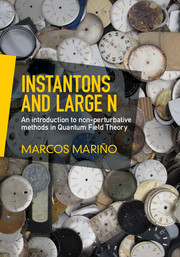Book contents
- Frontmatter
- Contents
- Preface
- Part I Instantons
- Part II Large N
- 6 Sigma models at large N
- 7 The 1/N expansion in Quantum Chromodynamics
- 8 Matrix models and matrix Quantum Mechanics at large N
- 9 Large N Quantum Chromodynamics in two dimensions
- 10 Instantons at large N
- Appendix A Harmonic analysis on S3
- Appendix B Heat kernel and zeta functions
- Appendix C Effective action for large N sigma models
- References
- Author Index
- Subject Index
7 - The 1/N expansion in Quantum Chromodynamics
from Part II - Large N
Published online by Cambridge University Press: 05 September 2015
- Frontmatter
- Contents
- Preface
- Part I Instantons
- Part II Large N
- 6 Sigma models at large N
- 7 The 1/N expansion in Quantum Chromodynamics
- 8 Matrix models and matrix Quantum Mechanics at large N
- 9 Large N Quantum Chromodynamics in two dimensions
- 10 Instantons at large N
- Appendix A Harmonic analysis on S3
- Appendix B Heat kernel and zeta functions
- Appendix C Effective action for large N sigma models
- References
- Author Index
- Subject Index
Summary
Introduction
In the previous chapter we studied the 1/N expansion in two-dimensional models in which the basic field has Ncomponents. As in those models, the key idea in the 1/N expansion of gauge theories is to realize that, in addition to the gauge coupling constant g, there is a hidden variable N, the rank of the gauge group. In YM theory with gauge group SU(N), the gauge connection is a matrixfield and it has N2 – 1 components, while in the two-dimensional models we studied before, the fields are vectorfields and they have Ncomponents. As a consequence, the 1/N expansion in gauge theories is very different from the expansion in vector models, and it was first worked out by 't Hooft. This expansion can be understood in diagrammatic terms, and it can be regarded as a reorganization (and resummation) of the standard perturbative series, by using the double-line diagrams (also called fatgraphs) introduced by 't Hooft.
The 1/N expansion of YM theory and QCD has led to many insights. A particularly spectacular prediction is the Witten–Veneziano formula, relating the mass of the η to the topological susceptibility of pure YM theory, which we will explain in some detail in this chapter. In contrast to the two-dimensional models of the last chapter, the exact solution of planar YM theory or planar QCD in four dimensions has been elusive. However, in recent years, it has been found that the planar solution of some supersymmetric gauge theories in four and three dimensions is encoded in a string theory, and this has led to an explosion in the development and study of large Ngauge theories. The next chapters might hopefully be used as an elementary introduction to this active and fascinating area of research.
Fatgraphs
The first thing to do when considering a 1/N expansion is to find the right scaling of the couplings of the theory. In the two-dimensional models of the previous chapter, we found that the coupling which stays fixed as Ngrows large is the 't Hooft parameter (6.2.4). Similarly, if g0 is the bare coupling constant of QCD introduced in (5.3.1), we will define the (bare) 't Hooft parameterof QCD as
- Type
- Chapter
- Information
- Instantons and Large NAn Introduction to Non-Perturbative Methods in Quantum Field Theory, pp. 216 - 241Publisher: Cambridge University PressPrint publication year: 2015



